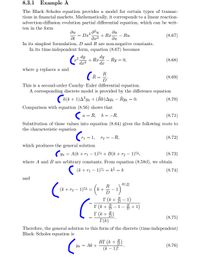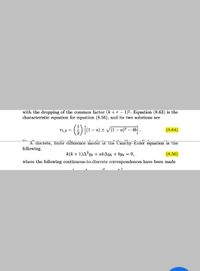
Advanced Engineering Mathematics
10th Edition
ISBN: 9780470458365
Author: Erwin Kreyszig
Publisher: Wiley, John & Sons, Incorporated
expand_more
expand_more
format_list_bulleted
Question
Explain the determine blue

Transcribed Image Text:8.3.1 Example A
The Black-Scholes equation provides a model for certain types of transac-
tions in financial markets. Mathematically, it corresponds to a linear reaction-
advection-diffusion evolution partial differential equation, which can be writ-
ten in the form
du
+ Rx
Ru.
(8.67)
Ət
In its simplest formulation, D and R are non-negative constants.
In its time-independent form, equation (8.67) becomes
dy
+ Rr dy
Ry = 0,
(8.68)
dx?
dx
where y replaces u and
R
(R=
(8.69)
D'
This is a second-order Cauchy-Euler differential equation.
A corresponding discrete model is provided by the difference equation
(k(k + 1)A?yk + (Rk)Ayk – Ryk = 0.
(8.70)
Comparison with equation (8.56) shows that
a = R, b= -R.
(8.71)
Substitution of these values into equation (8.64) gives the following roots to
the characteristic equation
r1
1,
2 = -R,
(8.72)
which produces the general solution
(yk
A(k + r1
1)"1 + B(k + r2 – 1)"2,
(8.73)
where A and B are arbitrary constants. From equation (8.58d), we obtain
(k + r1 – 1)"1 = k² = k
(8.74)
and
R/D
R
(k + r2 – 1)"2 = (k +
D
I (k + 5 – 1)
I (k + 5 – 1- 5 +1)
I (k+ 5)
T(k)
R
(8.75)
Therefore, the general solution to this form of the discrete (time-independent)
Black-Scholes equation is
ВГ (к + 3)
(k – 1)!
Yk = Ak +
(8.76)

Transcribed Image Text:with the dropping of the common factor (k +r – 1)". Equation (8.63) is the
characteristic equation for equation (8.56), and its two solutions are
r1,2 =
|(1 – a) + V(1- a)2 – 4b
(8.64)
11
A discrete, finite difference model of the Cauchy–Euler equation is the
following
k(k +1)A?yk + akAyk + byk = 0,
(8.56)
|
where the following continuous-to-discrete correspondences have been made
12
Expert Solution
This question has been solved!
Explore an expertly crafted, step-by-step solution for a thorough understanding of key concepts.
This is a popular solution
Trending nowThis is a popular solution!
Step by stepSolved in 2 steps

Knowledge Booster
Learn more about
Need a deep-dive on the concept behind this application? Look no further. Learn more about this topic, advanced-math and related others by exploring similar questions and additional content below.Similar questions
arrow_back_ios
arrow_forward_ios
Recommended textbooks for you
 Advanced Engineering MathematicsAdvanced MathISBN:9780470458365Author:Erwin KreyszigPublisher:Wiley, John & Sons, Incorporated
Advanced Engineering MathematicsAdvanced MathISBN:9780470458365Author:Erwin KreyszigPublisher:Wiley, John & Sons, Incorporated Numerical Methods for EngineersAdvanced MathISBN:9780073397924Author:Steven C. Chapra Dr., Raymond P. CanalePublisher:McGraw-Hill Education
Numerical Methods for EngineersAdvanced MathISBN:9780073397924Author:Steven C. Chapra Dr., Raymond P. CanalePublisher:McGraw-Hill Education Introductory Mathematics for Engineering Applicat...Advanced MathISBN:9781118141809Author:Nathan KlingbeilPublisher:WILEY
Introductory Mathematics for Engineering Applicat...Advanced MathISBN:9781118141809Author:Nathan KlingbeilPublisher:WILEY Mathematics For Machine TechnologyAdvanced MathISBN:9781337798310Author:Peterson, John.Publisher:Cengage Learning,
Mathematics For Machine TechnologyAdvanced MathISBN:9781337798310Author:Peterson, John.Publisher:Cengage Learning,


Advanced Engineering Mathematics
Advanced Math
ISBN:9780470458365
Author:Erwin Kreyszig
Publisher:Wiley, John & Sons, Incorporated

Numerical Methods for Engineers
Advanced Math
ISBN:9780073397924
Author:Steven C. Chapra Dr., Raymond P. Canale
Publisher:McGraw-Hill Education

Introductory Mathematics for Engineering Applicat...
Advanced Math
ISBN:9781118141809
Author:Nathan Klingbeil
Publisher:WILEY

Mathematics For Machine Technology
Advanced Math
ISBN:9781337798310
Author:Peterson, John.
Publisher:Cengage Learning,

